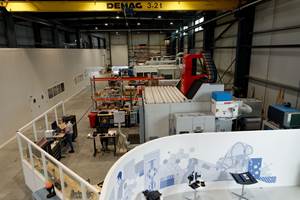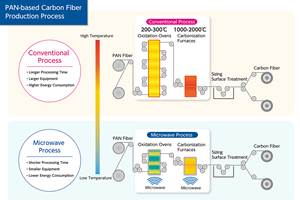The future of composites: The next generation
Columnist Dale Brosius reflects on what professional societies like SPE and SAMPE are doing to engage the next generation of composites leaders.
The spring season is usually busy, especially considering the number of conferences and trade shows this time of year. In March, JEC World was as active as ever, and immediately upon my return to the U.S. from Paris I headed to Detroit for the Society of Plastics Engineers (SPE) Annual Technical Conference (ANTEC). In late May, I traveled to Charlotte, N.C., for the annual SAMPE conference and exhibition. While each event gave me the opportunity to continue my own education about composites, so much of the value of attending is in catching up with industry acquaintances and numerous former colleagues, as well as meeting new folks heretofore unknown to me. The discussions help me keep up with the vibe of the industry, be that technical or commercial.
SPE and the Society for the Advancement of Material and Process Engineering
(SAMPE), organizers of two of the above events, are among the oldest professional societies serving the plastics and composites industries. In fact, SPE celebrated its 75th anniversary in 2017, and SAMPE its 75th this year in Charlotte. SPE represents a broad spectrum of plastics, and readers of this magazine are probably more familiar with its Automotive Composites Conference and Exhibition (ACCE) held in Detroit each September. This is organized by the Composites and Automotive Divisions of SPE. I have been on the organizing committee since 2005 and served as general chair of the conference four times. I have also been chair of the Thermosets and Composites Divisions during my many years of membership, which started back in 1992 when I attended my first SPE event, a Thermoset Division conference in Raleigh, N.C. My involvement with SAMPE goes back even earlier, with my joining the society shortly after I arrived in Detroit in 1984. Believe it or not, SAMPE was doing “automotive things” way back then! Over the years, I have been a session chair several times and have presented multiple papers at SAMPE conferences.
As it turns out, I am not alone in SPE or SAMPE longevity or engagement. Both societies are loaded with us “old timers,” so it is not unusual to run into each other at conferences. So many of the conversations we have include questions like “Where are you working these days?” and sentences starting with “Remember back when we…”. On that note, my September 2016 CW column was titled “The power of personal connections.” In it, I discussed the decline in membership in professional societies like SPE and SAMPE, and with that decline, the face-to-face networking that has enabled my success and that of my peers. This is not unique to our industry — it has been happening in all fields, as younger engineers and scientists rely increasingly on social media and apparently do not see the same value proposition in belonging to professional societies as I did when I joined. At the time, I noted that this shift was not lost on the leadership of SPE and SAMPE, and initiatives had been put in place to attract the next generation of members — and leaders.
You know what? Those initiatives seem to be working, at least in my observations. While both SPE and SAMPE have been very active in supporting students through poster sessions, bridge-building competitions and scholarships, getting these student members to continue as professional members has been difficult. Several years ago, SPE created the Next Generation Advisory Board, which brainstorms and implements ideas intended to engage graduate students and young professionals (up to age 35). A few of these initiatives have included targeted social events associated with ANTEC, and pairing students, young professionals and “seasoned” professionals on teams to conduct plastics or composites “quiz races,” engaging exhibitors on the show floor. SPE also offers a free membership to new young professional members for up to two years. Similarly, SAMPE offered a targeted Leadership Development Series for young professionals in Charlotte and has recently created the Young Professionals Emerging Leadership Awards. SAMPE also offers a monthly payment plan for membership dues.
At both ANTEC and SAMPE, there were numerous presentations by young researchers and engineers. Some of the most salient questions in the technical sessions were coming from the younger generations, asked from a base of fundamental understanding of composites. They are eager learners and are enthusiastically engaged. These young professionals are not “encumbered by experience.” They think in green terms like sustainability and resilience and, as consumers, are willing to pay a premium to achieve these objectives. Enabling technologies like automation, simulation, digitization and big data are not things they have to “get their arms around,” having been accustomed to these from the start.
I’m encouraged by what I see with these rising stars. As long as we keep them engaged and foster their development as leaders, the future of composites is in good hands.
Related Content
Plant tour: Daher Shap’in TechCenter and composites production plant, Saint-Aignan-de-Grandlieu, France
Co-located R&D and production advance OOA thermosets, thermoplastics, welding, recycling and digital technologies for faster processing and certification of lighter, more sustainable composites.
Read MoreCirculinQ: Glass fiber, recycled plastic turn paving into climate solutions
Durable, modular paving system from recycled composite filters, collects, infiltrates stormwater to reduce flooding and recharge local aquifers.
Read MorePlant tour: Middle River Aerostructure Systems, Baltimore, Md., U.S.
The historic Martin Aircraft factory is advancing digitized automation for more sustainable production of composite aerostructures.
Read MoreMicrowave heating for more sustainable carbon fiber
Skeptics say it won’t work — Osaka-based Microwave Chemical Co. says it already has — and continues to advance its simulation-based technology to slash energy use and emissions in manufacturing.
Read MoreRead Next
The power of personal connections
CW columnist and IACMI chief commercialization officer Dale Brosius suggests that composites industry “old-timers” need to figure out a better way to connect to the generations that are entering the composites workforce.
Read MorePlant tour: Daher Shap’in TechCenter and composites production plant, Saint-Aignan-de-Grandlieu, France
Co-located R&D and production advance OOA thermosets, thermoplastics, welding, recycling and digital technologies for faster processing and certification of lighter, more sustainable composites.
Read MoreDeveloping bonded composite repair for ships, offshore units
Bureau Veritas and industry partners issue guidelines and pave the way for certification via StrengthBond Offshore project.
Read More





















